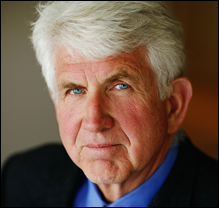
Robert Melancton Metcalfe

Stephen D Crocker, John F Heafner, Robert M Metcalfe, Jonathan B Postel. “Function-oriented Protocols for the ARPA Computer Network” Proceedings of the May 16-18, 1972, Spring Joint Computer Conference: 271-279. https://dl.acm.org/doi/pdf/10.1145/1478873.1478908
This publication stemmed from Metcalfe’s collaboration as a graduate student with core members of the small group engaged in setting up the ARPANET in the early 1970s. It gives a sense of the role of the IMPS, which Metcalfe had interfaced with MIT’s computer, in handling transmission across the network. The paper is also a snapshot of a moment just after the network’s first nodes were operational, when the first protocols for remote logins and file transfer were being developed.
Robert M Metcalfe & David R. Boggs. “Ethernet: Distributed Packet Switching for Local Computer Networks” Communications of the ACM 19:7 (July, 1976): 395-404.
Describes the original version of Ethernet, as deployed at Xerox PARC to network its custom-built Alto workstations. Packet switching had already been deployed on the ARPANET for slow communication over long distances, but its use for high-speed local networks was novel and highlighted in the article’s title.
David Boggs, John Shoch, Edward A. Taft, Robert M. Metcalfe. Pup: An Internetwork Architecture IEEE Transactions on Communications 28:4 (April, 1980):612-624
Pup, or PARC Universal Packet, was a collection of protocols developed by Metcalfe and others at PARC to run over Ethernet. Pup provided services such as email and file transfer and allowed for the routing of packets through network gateways, including connections to what became the Internet. It was further developed as XNS (Xerox Networking Service), the lower-level parts of which were placed in the public domain by Xerox and were widely adopted by local networking companies to transmit data over Ethernet. These included 3Com’s networking software and, with modifications, Novell’s Netware.
Further Reading
Robert M. Metcalfe. “Biographies: How Ethernet Was Invented” IEEE Annals of the History of Computing 16:4 (Oct-Dec 1994):81-88.
Gives Metcalfe’s own take on the invention of Ethernet, focusing on the early part of the story at Xerox PARC and on the patent he obtained with David Boggs, Chuck Thacker and Butler Lampson.
Urs von Burg, The Triumph of Ethernet (Stanford, CA: Stanford University Press, 2001).
A thorough and analytical history of the emergence of local area networking focused on the interplay of standards, producers, and adopters. It covers all of 3Com’s early competitors and the other networking technologies such as Token Ring that Ethernet eventually vanquished.
Pelkey, James L, Andrew L Russell, and Loring G Robbins. Circuits, Packets, and Protocols: Entrepreneurs and Computer Communications, 1968-1988. San Rafael, CA: Morgan & Claypool/ACM Books, 2022.
The book is based on a set of oral history interviews with important figures in the computer networking industry, including Metcalfe. Because the material was gathered in 1988, while the story was still unfolding, it gives a good sense of the twists and turns of events as seen by participants at the time.




























 THE A.M. TURING AWARD
THE A.M. TURING AWARD